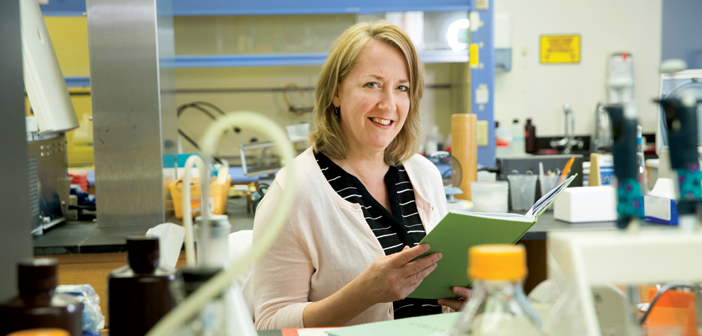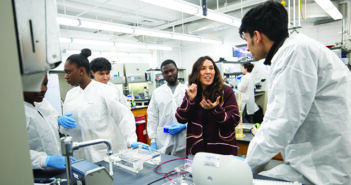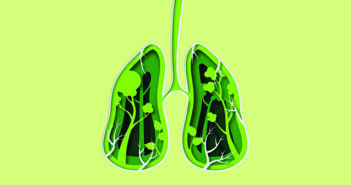She says she’s not a superwoman, but she’s using her power for good.
Elizabeth Harrington, PhD, cherishes her friends and her family, even her dog who eats rocks and racks up astronomical vet bills. But she’s a scientist through and through, so much so that a friend once teased that she needs a scientific study to prove how important friendships are.
She lets out a delighted laugh as she tells this story. “I like to surround myself with funny people because I’m not funny,” Harrington says.
Maybe she’s not a standup comedian, but she has a ready smile and a sparkle in her eye—a healthy counterpoint for someone whose work is so pivotal, and so broad. She’s the associate dean for graduate and postdoctoral studies in Brown’s Division of Biology and Medicine, a professor of medicine (research), the principal investigator or co-PI on numerous grants ranging from her studies of acute lung injury to programs that support students from backgrounds underrepresented in the life sciences, and deputy director of a five-year cardiovascular and pulmonary research grant.
A nationally respected researcher in her field, she’s held key positions in various professional organizations, including the American Thoracic Society and the American Heart Association, and she’s an associate editor of Lung. She’s trained MDs and PhDs, travels often for conferences and visiting professorships, and manages a lab at the Providence VA Medical Center.
But that’s not all. At home in Holliston, MA, are her husband (and college sweetheart), Mark, who works at Boston University, and their children, William, 15, and Emma, 13. “There are crunch times and there are freedom times,” Harrington says. The family spends that down time enjoying New England life: skiing, beaches, fishing off their Boston Whaler. “Your kids are only young once,” she says.
Clear Trajectory
A Pennsylvania native, Harrington moved to Rhode Island in high school when her father, a radiologist, took a job at Cranston General Hospital. She always liked science and math, and majored in biology at St. Joseph’s University, in Philadelphia, but didn’t want to follow her dad and her brother, a pulmonologist, into medicine. After working for two years as a research technician at Boston University Medical Center, “I realized to be a boss,” she says, “I needed my PhD.”
She returned to Philadelphia to earn her doctorate in biochemistry at Hahnemann University, and then was back in Boston for her postdoc, studying heart vasculature with a Harvard cardiologist. “I loved it,” she says, but when she was looking for a new research position, in 1997, her brother urged her to talk to Sharon Rounds, MD, a professor of medicine and of pathology and laboratory medicine at Brown who studies pulmonary circulation and lung injury and disease.
“We were very lucky,” says Rounds, a staff pulmonologist at the VA. “Beth’s brother was here in Providence practicing pulmonary. … [He] recommended she talk to me. We talked and I said, ‘You’re hired,’ on the spot.
“It’s been a very, very mutually productive relationship,” Rounds says.
Within a year Harrington had landed career development funding and a faculty appointment. (“She just blasted away,” Rounds says.) She focused her research on the role of proteins in pulmonary endothelial cell function and how they regulate response to injury. In 2001, Rounds invited James Klinger, MD F’91, a pulmonologist at Rhode Island Hospital who studies pulmonary hypertension and how natriuretic peptides affect endothelial cell integrity, to join her Vascular Research Laboratory at the VA. Within a few years, he says, “Beth and I started putting our ideas together to see if natriuretic peptides had an effect on [blood vessel]leakage into the lungs. … It worked pretty well.” They published their first paper together in 2006 and have been collaborators ever since.
In addition to a National Heart, Lung, and Blood Institute (NHLBI) research project grant on natriuretic peptides in acute lung injury, of which she’s co-PI with Klinger, Harrington is PI or co-PI on two NIH training grants; manages the Vascular Research Laboratory core lab; and is deputy director, core PI, and mentor on the CardioPulmonary Vascular Biology Center for Biomedical Research Excellence (COBRE), which Rounds directs. “It’s fantastic because she brings organizational skills that I just don’t have,” Rounds says. “We’ve really complemented each other.”
Rounds continues: “As our relationship has matured, she mentors me as much as I mentor her—scientifically of course, but also from the point of view of organizing, management techniques. … It’s definitely one of colleagues, and not mentor-mentee. It’s gotten to the point I’m actually flattered if she asks my advice.”
Level the Playing Field
In 2010 Nancy Thompson PhD’86 retired as associate dean for graduate and postdoctoral studies, and Rounds encouraged Harrington to apply for the job. “I’d been doing research here for 13 years, and it was a nice complement to the science I was doing,” Harrington says. “I was ready to learn something different.”
Associate Dean of Biology Edward Hawrot, PhD P’14, who supervises Harrington, says, “I’m very grateful to Sharon.” Under Harrington, Hawrot has seen an uptick in faculty involvement in training grants, professional development workshops, and the Responsible Conduct in Research course, which is required for all doctoral students. He also credits her office for increasing external training grant and predoctoral fellowship funding, which last year allowed the division to bring in 44 PhD students—“the highest number ever,” he says, even as peer schools, due to funding uncertainties, are holding or even reducing their admissions.
“She’s good on an individual, one-on-one basis with students,” Hawrot adds. “She also does a great job with postdoctoral fellows.” That advocate role is one of the responsibilities that Harrington says attracted her to the deanship. She helps match students with faculty advisers, ensures they get the training they need to succeed, and acquaints department directors with University resources available for students who need extra support.
Postdocs are more of a challenge, Harrington says. They’re not students, but they’re not faculty either. “They tend to focus on the job at hand in the laboratory, rather than have a strong tie to the University,” she says. Her office started a travel award program to help postdocs attend conferences and present their work, and encourages them to take advantage of professional development and teaching seminars and opportunities to mentor undergrads. “I’m very much looking for them to develop their skill set outside of bench work because it’s very important to their career trajectory,” she says.
Rounds saw that dedication to students and trainees early on, when she asked Harrington to work with an undergraduate in her lab as part of Brown’s Leadership Alliance Summer Research-Early Identification Program. Funded by the NHLBI since 1992, the program offers paid internships with faculty mentors for underrepresented students interested in pursuing research doctorates. Of the 230 students who have participated in the program, 82 percent have gone on to graduate school, says Harrington, who is now the training grant PI.
That experience, as well as her everyday work as a mentor to grad students and postdocs, made her a natural fit to become codirector of the BioMed Initiative to Maximize Student Development (IMSD), in 2012. The program offers research training for doctoral students who are underrepresented in the life sciences, including additional career and skills development, stipends, and conference travel funding. Harrington and her IMSD codirector, Andrew G. Campbell, PhD, associate professor of medical science, identify matriculated students for program support, based not only on factors such as race, ethnicity, and gender but also where they earned their bachelor’s degree.
“Science classes are among the most expensive classes to run,” Campbell says, so students coming from underresourced colleges may not have adequate training in “early gatekeeper courses,” such as physics, to keep up when they get to Brown. “We have modules to teach that gap,” he says. “The only difference [between IMSD and non-IMSD students]is resources, opportunity, and access, and we’re trying to correct that.”
Since its founding in 2008, the IMSD has supported 47 PhD students, 40 percent of whom have completed their degrees. Campbell and Harrington work together to build a strong peer network among the students, match them with advisers, and support faculty mentors as well. “Beth is very good at recognizing a student’s needs,” Campbell says, and she’s “the first line when mentors and students are trying to figure out their relationship.”
Most of the graduate programs in BioMed have recruited more diverse student bodies in recent years, what Campbell calls “the IMSD effect.” In 2014, Brown was ranked 11th in the US for the number of African Americans who earned PhDs in the biological sciences. The University, seeing the success of the IMSD, is now hoping to expand the program to the other STEM fields (science, technology, engineering, and math) and public health. Campbell and Harrington will draw on the data they’ve gathered on the IMSD (they’re co-PIs of the NIH training grant that funds it) to ensure the model will work beyond BioMed.
“We’ve identified best practices of how to recruit and retain so students are as competitive post-grad school as any other student,” Harrington says. “To accommodate the expansion into the additional STEM programs, where needs are lacking from undergrad, we need to develop additional modules geared toward this cohort to bring them up to speed.”
“The institution recognizes Beth and I as resources, and they will support our efforts to implement a program that works to serve everyone,” says Campbell, who in July will become the dean of Brown’s Graduate School. He adds of his IMSD partner: “She doesn’t just talk the talk. This isn’t just some administrative function. There’s more to it than that for her.”
Bench to Broadside
Harrington’s colleagues marvel not only at the breadth and depth of her professional achievements, and at her warmth and heart on the job, but that she’s able to balance it all with a great personal hardship.
Both Rounds and Klinger remember vividly the day in 2009 when they got the news. “I read it as I was getting on an airplane—a message from Beth about her daughter,” says Klinger, the pulmonary hypertension expert. “I had to wait until I was off the plane until I could call her and find out what was going on.”
Emma, then age 6, had collapsed as the family walked to church, unable to breathe. Her parents rushed her to Boston Children’s Hospital, where doctors found the blood pressure in her lungs was dangerously high. Harrington understood immediately what it was: pulmonary hypertension. “It was really a kick in the stomach,” she says.
Pulmonary hypertension is a rare disease in which the arterioles and capillaries of the lung are abnormally narrow or blocked, building up blood pressure and taxing the right side of the heart. When it’s diagnosed in children, their circulation systems are still growing—the heart is developing, the lung is adding blood vessels. Though kids don’t usually outgrow it, their prognosis is better than adults’, Klinger says. But there is no cure.
“It was a sudden and unfair way of sharing this disease between Beth’s daughter and our research,” Klinger says. By then they’d been investigating pulmonary endothelial cells, which seem to grow abnormally in pulmonary hypertension, for a few years. The coincidence was often a cause for comment. “A lot of people said to me, that’s interesting,” Harrington says. “I said, there’s nothing interesting about it. It stinks.”
Emma has responded well to treatment, which usually bodes well for the long term. She takes daily medication and is using oxygen only at night now, and her physicians at Boston Children’s are optimistic. She dances and plays with friends, though she does tire quickly. “We hope, as time goes by, that kids with the disease now will have a better prognosis,” Klinger says. “We hope to find a cure.”
The diagnosis hasn’t altered Harrington’s research focus. “I haven’t changed my model because I’m so established in acute lung injury,” she says. “But I’m more critical of the literature, the drugs, and the action of the drugs now.”
Nor has it changed her dedication to her work. “If she has to go home because Emma fainted at school,” Rounds says, “you know she’s going to be online and working.”
Harrington says people often ask her how she does it all. “I don’t know. I just do it,” she says. “What am I going to do at home, just sit there and be sad? …
“One of the things I think is really important is to serve as a role model to the next generation,” she adds. “You don’t have to be superwoman, but you don’t have to compromise your career to have a home life. I try to tell them it’s doable.”




